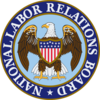Board Issues Final Rule on Joint-Employer Status
Office of Public Affairs
202-273-1991
publicinfo@nlrb.gov
www.nlrb.gov
**Note: A U.S. District Judge stayed the joint-employer rule until March 11, 2024.
Today, the Board issued its Final Rule addressing the Standard for Determining Joint-Employer Status under the National Labor Relations Act.
Under the new standard, an entity may be considered a joint employer of a group of employees if each entity has an employment relationship with the employees and they share or codetermine one or more of the employees’ essential terms and conditions of employment, which are defined exclusively as: (1) wages, benefits, and other compensation; (2) hours of work and scheduling; (3) the assignment of duties to be performed; (4) the supervision of the performance of duties; (5) work rules and directions governing the manner, means, and methods of the performance of duties and the grounds for discipline; (6) the tenure of employment, including hiring and discharge; and (7) working conditions related to the safety and health of employees.
In adopting this new standard, the final rule rescinds the 2020 final rule that was promulgated by the prior Board. The new final rule more faithfully grounds the joint-employer standard in established common-law agency principles. In particular, the 2023 rule considers the alleged joint employers’ authority to control essential terms and conditions of employment, whether or not such control is exercised, and without regard to whether any such exercise of control is direct or indirect. By contrast, the 2020 rule made it easier for actual joint employers to avoid a finding of joint-employer status because it set a higher threshold that a putative joint employer must “possess and exercise . . . substantial direct and immediate control” over essential terms and conditions of employment, which has no foundation in common law. The new rule also provides extensive guidance to parties regarding their rights and responsibilities in situations where joint-employer status has been established.
“The Board’s new joint-employer standard reflects both a legally correct return to common-law principles and a practical approach to ensuring that the entities effectively exercising control over workers’ critical terms of employment respect their bargaining obligations under the NLRA,” said Chairman Lauren McFerran. “While the final rule establishes a uniform joint-employer standard, the Board will still conduct a fact-specific analysis on a case-by-case basis to determine whether two or more employers meet the standard.”
The Notice of Proposed Rulemaking was published by the Federal Register on September 6, 2022 and the comment period for initial comments was open until December 7, 2022. The Board received over 13,000 comments that it reviewed and considered in drafting the Final Rule. The effective date of the new rule is December 26, 2023, and the new standard will only be applied to cases filed after the effective date.
Members Prouty and Wilcox joined Chairman McFerran in issuing the Final Rule. Member Kaplan dissented.
View a fact sheet on the new rule.
Established in 1935, the National Labor Relations Board is an independent federal agency that protects employees from unfair labor practices and protects the right of private sector employees to join together, with or without a union, to improve wages, benefits and working conditions. The NLRB conducts hundreds of workplace elections and investigates thousands of unfair labor practice charges each year.


